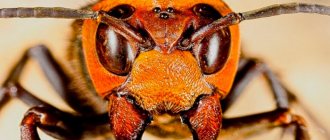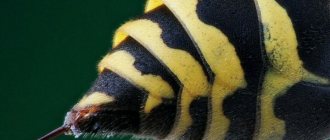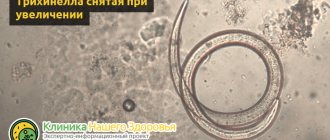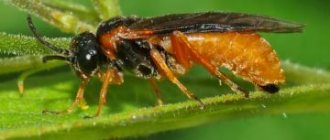Summer is a wonderful time of year, because this period is so rich in all kinds of fruits and berries. But do not forget that juicy fruits and nectars are loved not only by people, but also by insects such as bees and bumblebees.
Therefore, it is necessary to remember simple rules of behavior in nature and closely monitor your children.
Unlike ordinary people, for whom a bee or bumblebee sting will only bring temporary inconvenience, for a small child or allergy sufferer an encounter with such insects can be life-threatening.
Everyone should know how to behave in this situation and what first aid to provide to the victim.
Types of bumblebees and their bites
Bumblebees number at least 300 species and represent the bee family. Like bees, bumblebees are social insects and therefore live in colonies. They are engaged in collecting nectar from flowers, actively pollinating plants.
The most common species found on our territory include:
- Purple bumblebee , also called "carpenter". The body of this insect is black, and the wings have a violet-blue tint. The wingspan reaches 3 cm. The species is non-aggressive, but its bite is quite unpleasant.
- Stone bumblebees , growing in length to almost 30 mm. The body of the insect is covered with black bristles. It differs in that it has a red belly. They prefer to live in numerous colonies. The bite of this insect can cause an allergic reaction, although it is quite rare.
- The ground bumblebee , which prefers to live in the ground. To do this, he uses empty mouse holes. They grow up to 27 mm in length. The body of the ground bumblebee is black with yellow bristles, as well as yellow stripes on the chest. Females are somewhat larger in size compared to males, and they are armed with a sting. They bite on rare occasions.
- Garden bumblebee , which is not large (only 15-23 mm) in size. The abdomen is yellow, and in the middle between the wings there are black bristles. Garden bumblebees live in the hollows of various trees, in rotten stumps, and also in the ground, looking for cracks.
It should also be noted that there are field and urban bumblebees.
Important point! Each bumblebee colony has an average of up to 150 individuals. Discovering a colony is not so easy, since the nest is guarded and carefully camouflaged.
About a bumblebee bite: a bumblebee bites, the consequences, how it bites, the sting, how long it lasts
The bite of a bumblebee or a predatory representative of the Hymenoptera genus is a defensive reaction of the female or uterus against an imaginary or real attack by a person, since only they have a sting.
Further in the text we will tell you what a bite looks like, about its consequences, ways to eliminate them and preventive measures, the observance of which will allow you to avoid poisoning with a toxic poison.
Bumblebee sting
There are many types of bumblebees in nature; below we will consider 4 main types of bites, which differ in their symptoms.
Types of bumblebees and features of their bites:
- After an attack by a purple predator from the insect family, the victim feels painful sensations at the point of contact between the skin and the sting.
- After being bitten by a rock bumblebee, an allergic reaction is possible.
- Ground and garden bumblebees are considered the most harmless, their bites are least likely to cause adverse consequences.
- The Asian bumblebee is considered the most dangerous - the venom of this specimen contains a rich complex of substances dangerous to humans and can not only kill the victim the first time, but also attract other members of the genus with its smell for subsequent attacks.
Bumblebee bite and its consequences
Healthy. The bite is considered poisonous to humans, since a toxic substance that poisons the body enters the victim’s body through the sting.
The entry of poison into the blood can provoke an allergic reaction, which, in turn, is expressed by:
- temperature rise,
- itching in the area of damaged skin and rash throughout the body;
- the appearance of swelling and blisters.
In addition to external manifestations of exposure to a toxic substance, internal ones can also be observed:
- nausea;
- dizziness;
- tachycardia;
- labored breathing;
- attack of suffocation;
- loss of consciousness;
- frequent muscle contractions;
- lack of pulse, pallor;
- multiplicity of spasms throughout the body;
- joint pain.
Appearance of the bite
To understand how a bumblebee bites, you should pay attention to the fact that after an insect attack, a hole remains, around which over time the skin can turn red and swell, forming a dense lump.
Duration of action of the poison
The effect of a toxic substance containing an allergen in the form of a protein, after it enters the bloodstream, can last from an hour (within 30-40 minutes the pain subsides) to 3-4 days. Then the main symptoms described above disappear.
Good to know. Despite the fact that bumblebee venom is considered toxic, it is harmless compared to the substance released during a bee attack.
Popular bite spots
The most common places where a striped insect can bite are the arms, legs and head. In the first and second cases, a bumblebee may bite if they try to catch it or trample on its house. The latter situation may arise in the case of collecting honey without special equipment.
Healthy. A bite to a limb is safe, unlike damage to parts of the head: nose, mouth, eyes, ears, lymph nodes. If the latter are affected, you should urgently consult a doctor, since the poison enters directly into the blood, and the reaction to the entry of a foreign substance into the body will be instantaneous.
Insect nests are most often found on the ground: inside holes, stumps or in the sand, unlike bees, which prefer trees.
Bite procedure
During the attack, the “needle” pierces the surface of the epidermis, and through it a mixture of protein, peptides, amino acids, aliphatic compounds and serotonin (lowers blood pressure) enters the victim’s body, which cause the above effects.
Reason why the bumblebee sting is safe
Bumblebee bite - what to do at home
The main reason why the insect lives, unlike bees, representatives of the same family, even after attacking a person is the structure of the sting, which looks like a hollow needle.
Healthy. The smooth surface of the bumblebee sting not only allows you to remove the “weapon” from the site of the attack painlessly, both for the stinger and the stung, but also to repeat the biting procedure several times.
Ambulance
Hornet sting - what to do at home
If you are stung by a bumblebee, you need to take the following steps:
- remove the sting (if it remains) with tweezers, after treating it with hydrogen peroxide or alcohol;
- rinse the skin puncture site with clean water;
- anoint with a disinfectant solution in the form of hydrogen peroxide or chlorhexidine;
- put cotton wool or a bandage soaked in lemon or apple juice on the bite site for pain relief and partial neutralization of the poison;
- apply aloe to speed up wound healing;
- place ice or a cold towel on the infected area to narrow the area of infection and reduce swelling;
- drink hot, very sweet tea;
- take any medication from the antihistamine group to exclude a possible allergic reaction;
- If the condition worsens or the affected area becomes suppurated, you should immediately contact a medical professional.
After a bite, you should never:
- scratch the wound site, as you can speed up the spread of poison and cause infection;
- press on the wound to extract the poison, as such actions can lead to blood poisoning;
- drink alcoholic beverages - alcohol will dilate blood vessels, helping the poison spread throughout the body faster, which helps to increase swelling several times;
- visit a sauna, bathhouse, so as not to cause a delayed allergic reaction.
Healthy. To minimize the effect of the poison, it is recommended to drink clean water in large quantities so that the toxic substance dissolves in it.
Use of medications
In addition to providing emergency care immediately after a bite, it is recommended to use medications that are used in accordance with the groups of consequences.
Allergy remedies
If an allergic reaction occurs, you should seek help from the following antihistamines; the result will be visible within 30 minutes:
- demidrol - it is advisable to take 1-2 tablets 3 times a day for 10 days;
- Suprostin - since the drug contains a side effect in the form of drowsiness, it is recommended to take 1-2 tablets before bedtime;
- Diazolin - take 1 tablet until the adverse symptoms disappear.
Treatment of external consequences
In case of a tumor or swelling of individual parts, experts advise to smear:
- hydrocortisone – taken externally up to 3 times every 8 hours;
- as a rescuer - apply a thin layer to the injured area and let it dry, repeat the action up to 2-3 times a day;
- psilobalm - treat the working surface with 3 g of the substance, repeating the procedure up to 4 times within 24 hours.
Healthy. If there are no complications after an insect bite, then the swelling and swelling will go away in 48-96 hours.
Traditional methods
You can use for treatment not only drugs containing chemical elements, but also mixtures of natural components, recipes for which will be given below:
- Grind the plantain leaves and put them on a bandage. Apply the finished compress to the wound and change the bandage every 3 hours.
- Take half a teaspoon of tansy, pour a glass of water over the herb and cook for 300 seconds over low heat. Allow the solution to cool, then moisten a cotton swab in it and apply the resulting compress to the wound. Change the bandage when it is dry.
- Wash and cut fresh potatoes into rounds and apply each of them, the last one is placed when the previous one has dried, to the site of injection of the poison.
- Rinse the bite area under running water, then put banana pulp on it to reduce itching.
Healthy. To remove most of the poison from the body, simply apply a wet lump of sugar to the wound.
The danger of a bumblebee bite
If you are bitten by a bumblebee, then no harm to your health can be expected if you are not allergic to the poison, but in the event of an attack by several representatives of the bee family, not only superficial allergic reactions are possible, but also more severe consequences, expressed in a malfunction of the heart, nervous system, and eyes.
If the victim is intolerant to a toxic substance, the risk of death increases, since swelling at the point of contact of the insect sting and human skin begins to grow at a high rate. A similar reaction can also occur in the case of repeated administration of poison.
It is also worth pointing out that the bite is most harmful to children under 6 years of age, pregnant and lactating women, since all cases of poison entering the body can lead to irreversible changes in the baby’s immune system, including death. People suffering from a predisposition to allergic reactions and vascular diseases may also be at risk.
Important! The victim may die if targeted bites are made to the head, namely in the mouth and nose area, since then there is a risk of anaphylactic shock.
Prevention of poisonous bites
To prevent a bumblebee attack, it is advisable to:
- do not provoke an attack - stay as far away from the insect as possible;
- collect honey in special clothes if there is an apiary on the property;
- do not be in a place where insects accumulate while intoxicated;
- do not use perfume in excess if an encounter with a bumblebee is inevitable;
- in the summer, protect the house from insects entering it by placing mesh on the openings;
- do not make sudden movements in the presence of a representative of the Hymenoptera genus;
- If possible, wear clothes of soft colors, especially in the evening, so as not to attract the attention of the insect.
To summarize, it is worth noting that it was indicated why a bumblebee bite is dangerous for humans, and what consequences it can lead to. Precautions for contact with a bumblebee and methods of treatment if a bite was received were also presented.
Healthy. Finally, it is worth saying that in order to avoid or reduce the risk of harm to health, it is advisable to communicate with the creatures of nature as carefully as possible and consult a doctor before treating a wound yourself.
7ogorod.ru
Bumblebee's sting
As mentioned above, the sting is present exclusively in females, as well as in the uterus. Compared to a bee's sting, a bumblebee's sting does not have barbs, so after a bite the sting does not remain in the victim's body.
The design of the sting is such that it has a channel formed inside it, through which, during a bite, the insect injects poison, which consists of fats and proteins, peptides, amino acids, as well as aliphatic compounds.
Interesting to know! Compared to a bee, which dies after being bitten, a bumblebee, having bitten once, is able to bite again, since it does not leave a sting, which means it does not die.
Dangerous insects: does a bumblebee bite or not?
Everyone knows that bees sting. But not everyone knows whether a bumblebee bites or not and whether its bite is dangerous for humans. This insect can sting if provoked.
About bumblebees and bumblebee venom
A bumblebee is a sessile-bellied insect from the bee family. There are about 300 types of these insects on the planet. They are not afraid of the cold and can quickly warm up their bodies to 40°C, which gives them the opportunity to be the first to begin collecting nectar in the morning, when it is still cool and the bees are inactive.
Bumblebees are yellow and black in color, often with stripes. There are insects with orange or red stripes, and there are individuals that are simply black.
Large bumblebee nests consist of 150-200 insects. They can choose old stumps, cracks in the ground, abandoned mouse holes as nests, and also build dwellings on sandy cliffs. It is difficult to find a bumblebee nest - the insects hide it well.
The sting of a bumblebee is devoid of serrations and rarely remains in the body of the victim, which is different from the sting of a bee.
Inside, the bumblebee's stinger is hollow, like a needle in a syringe. Through it, during a bite, an insect injects a microscopic portion of poison, causing pain, itching and irritation.
Bumblebee venom is a protein mixture, which is why the insect bite causes an allergic reaction in many people. Bumblebee venom contains serotonin, which lowers blood pressure, which can result in shock.
Bumblebee sting with drops of poison
However, this is strictly personal. Most people survive an insect bite without problems. If a bumblebee bites you for the first time, then most likely there will be no allergic reaction, because the body does not have antibodies to this poison. They often appear with subsequent bites. Typically, an allergic reaction makes itself felt in the first half hour from the moment of the bite and is accompanied by itching, redness and swelling of the entire body, vomiting, nausea or diarrhea, and signs of suffocation may appear.
Later, fever, convulsions, chills, joint pain, and fainting may be added to the above symptoms. Such symptoms require immediate hospitalization, otherwise the consequences may be unpredictable.
Simultaneous bites from a large number of insects pose a great danger. A toxic reaction may develop, causing complications in the functioning of the heart and central nervous system.
Wasps, bumblebees and bees pose a particular danger to people with allergies, as well as to pregnant women and young children.
Their potential for an allergic reaction to insect bites increases many times over.
Apply ice to the bite site - this will slow down the spread of poison throughout the body
Recommendations for stinging insect bites
- If the sting remains in the body, you need to pull it out with treated tweezers. There is no need to try to squeeze it out with your fingers, so as not to infect the victim.
- The wound should be immediately treated with hydrogen peroxide, alcohol, vinegar, or cotton wool soaked in one of the listed products.
- Apply a piece of ice or a cold compress to the bite site, especially if it is around the eyes or other sensitive area. Cold will relieve swelling, reduce pain and slow down the absorption of poison. To extract the poison, you need to apply a piece of sugar moistened with water to the damaged area.
- The victim should be given plenty of liquid to drink, preferably hot tea with sugar. If the victim does not get better, or symptoms of an allergic reaction appear, then you should immediately call a doctor.
Treatment of insect bites at home
In most cases, a bumblebee bite can be safely treated at home. For example, you can put a fresh leaf of plantain or parsley on the injured area and replace it with a new one every 2 hours.
You can apply a chopped onion, apple, raw potato to the damaged area, or chop 2 cloves of garlic, mix with honey and attach this mixture to the bite. The bandage must be changed twice a day.
Lemon juice and a compress made from it will also help.
Bumblebee sting
You can also dilute baking soda with water until a slurry forms and apply to the affected area, or prepare a solution of soda (1 teaspoon per glass of water), soak cotton wool in it and apply for a quarter of an hour.
Grind the activated carbon, add water until a paste forms, place it on the bite site and cover with film to prevent rapid drying.
If there is no activated carbon, apply validol moistened with water to the damaged area. You can also use medications, for example, Fenistil gel, which successfully relieves irritation. The damage should be lubricated with gel 3 times a day. The medicine begins to act immediately after application. If you are bitten by insects, you should not drink alcohol, as this leads to increased swelling.
Often people unwittingly provoke insects by waving their hands, trying to drive them away. This behavior, as well as the smell of perfume, alcohol, and fried meat, only attract and irritate bumblebees.
The smell of perfume attracts bumblebees
When should you go to the hospital?
- If several bumblebees or bees were bitten at the same time.
- When a child or elderly person is injured.
- If the bite occurs in the eyeball or mucous membrane of the mouth.
- When previous insect bites caused an allergic reaction.
- There are symptoms of infection: severe chills, swelling, pain, the bite site becomes purulent.
When a bumblebee bites, it is less painful than a bee or wasp sting because its venom is not as dangerous as that of a bee or wasp. In addition, a wasp can bite several times.
bumblebee nest
Conclusion on the topic
Knowing that bumblebees bite, do not provoke these insects. Try to avoid the places where their nests are located. Where bees, bumblebees or wasps are present in large numbers, it is undesirable to eat sweets, watermelons, melons, and drink sweet drinks.
Although bumblebees bite, there is no need to destroy them, because they pollinate plants well, and their honey contains protein, sucrose, many minerals and is very healthy.
bezvrediteley.ru
The danger of a bumblebee bite
As a rule, a bumblebee bite does not pose any danger to humans, with the exception of those people who are prone to allergies.
Important fact! In the event of a repeated bite, the likelihood of an allergic reaction is much higher, since the human body begins to produce toxins that neutralize the insect's venom.
A bumblebee bite poses a certain danger to expectant mothers and nursing women, as well as children whose immune systems have not yet strengthened. Bites to the face (eyes, nose), as well as to the neck or ear will not pass without leaving a trace. As a result of the action of the poison, edema may appear, which will make it impossible for these organs to function normally.
In the case of a bite in the leg or arm, if the sting does not get into a blood vessel, there are no negative manifestations. The appearance of edema is associated with the individual characteristics of the body.
Most often bumblebees bite:
- In the hand or finger when a person brushes off bumblebees.
- In the foot when a person accidentally steps on a bumblebee feeding on flower nectar.
BITTE BY A BUMBLEBEE? WHAT HAPPENS IF A BUMBLEBEE BITES YOU
If a bumblebee bites your leg and it becomes swollen
All unpleasant sensations arising from a sting are associated not with the puncture of the skin, but with the poison injected under it. Therefore, compaction and the manifestation of a local reaction in the form of severe pain and itching are normal. In most cases, swelling of the bite site occurs as a response of the human immune system to toxic compounds entering the body.
Bumblebee sting
What to do if you swallow a wasp
Under the influence of poison, the walls of cell tissues are destroyed, lymph accumulates and soft tissue around the wound increases. This reaction of the body is typical and is aimed at quickly neutralizing intoxication. A swollen leg can be immersed in cool water to relieve the burning sensation. Antihistamines are taken for preventive purposes. The symptoms gradually weaken and go away on their own.
When asked what to do if you are stung by a bumblebee and the swelling on your leg does not subside or spreads further throughout the body, the answer is: seek professional help.
Additional Information. In people with different pain thresholds, the symptoms and sensations from a bumblebee bite can be expressed with varying degrees of strength.
It is considered normal for the pain to subside within the first 30 minutes after the bite; the subcutaneous thickening may subside over the course of several days to several weeks.
Why do bumblebees bite people?
Bumblebees, compared to bees, are more peaceful in nature and bite only in rare cases, for the purpose of self-defense or to protect an entire colony.
The insect can attack a person in other cases. For example:
- In the presence of a strong aroma of perfume, the smell of alcohol (fumes), or oxidizing metal.
- In the case of a predominance of blue clothing, as well as in the case of sudden movements, which clearly provokes aggression of the insect.
Important to remember! The more insect bites, the more dangerous they are for humans, since a high level of toxins in the body can lead to disruptions in the functioning of many organs, including the nervous and cardiovascular systems, as well as the respiratory system. In this case, death is possible as a result of cardiac arrest or paralysis of the respiratory system.
Can bumblebees sting humans?
Initially, leisurely insects are not aggressive. The bumblebee is conditionally dangerous for humans, that is, its attack occurs under a certain set of circumstances:
- a threat to the safety of the colony or a danger to a specific insect;
- mechanical destruction of the nest;
- the smell of oxidizing metal, perfume, alcohol from a person (and old fumes are perceived even more aggressively);
- the predominance of deep blue shades in clothing or the environment;
- sudden movements in close proximity to the insect.
The sting of any bumblebee is different from the sting of bees. The latter have a jagged sting, so after a successful attack it remains in the victim’s body. The bumblebee’s “biting device” is smooth and freely removable. Therefore, the same bumblebee can sting people and animals multiple times.
Stinging attacks are carried out exclusively by female bumblebees. Only their mouthparts are equipped with a sting, inside of which there is poison from bombolithine, serines, phospholipase A2, a mixture of proteins and aliphatic compounds.
Males are also capable of defending themselves, but they use their mandibles. Although the bite is noticeable, due to the lack of poison it is harmless to people and animals.
Symptoms and appearance of the bite
The body's reaction to an insect bite has nothing to do with whether the sting is left or not. Since bumblebees bite humans much less often than bees, few people know about the symptoms, much less the consequences of a bite.
As a rule, the consequences of a bite are as follows:
- Severe pain appears.
- Unpleasant sensations resulting from itching and burning.
- Tissue edema and severe swelling appear with thickening of the bite site, as evidenced by the photo.
Similar symptoms appear immediately (within a few seconds) after the bite. Negative manifestations (discomfort) last for a certain time and depend on the characteristics of each person’s body. This may continue for several days. If you constantly scratch the bite site, the problem may worsen.
An allergic reaction also does not appear immediately, depending on how actively the body produces an antidote to bumblebee venom, which also poses a certain danger.
Allergic reactions are manifested in the following:
- Swelling and redness spread over large areas of the body.
- A rash or large blisters appear on the skin.
- Nausea, vomiting and diarrhea may occur.
- The appearance of breathing problems, with the onset of suffocation.
- The appearance of severe chills, against a background of high temperature.
- Problems with the functioning of the cardiovascular system.
There is a possibility of anaphylactic shock, with dizziness, suffocation, convulsions, including fainting. In this case, it is better to immediately call an ambulance.
In the case of multiple bumblebee bites, you can observe:
- General weakness and dizziness.
- Nausea.
- Increased or slow heart rate.
Does a bumblebee sting or not, photo of the sting
There is a widespread belief that bumblebees, unlike many bees, do not have a stinger. This is not entirely true; this opinion is rather a misconception. In fact, bumblebees, as well as bees and wasps, can cause a lot of problems. Yes, they are less aggressive, this is a fact, but this does not mean that communication with a bumblebee is guaranteed to be without bites. On the contrary, bites are very possible.
Is there a sting?
Bumblebees have a sting. But not everyone does. It is present in working varieties of bumblebees (namely females), as well as in the queen. In general, bumblebees are quite similar to bees, moreover, they belong to the species of so-called “real” bees, and their principle of existence is very similar - both insects search for nectar, live in small groups and protect accumulated reserves. But when it comes to bites, everything is different.
It is known that a bee stings only once. This happens due to the fact that it has serrations on its sting. As a result, after being bitten, she cannot remove it. If the bee tries to take it out, then at best it breaks off. But the bumblebee has a smooth sting, so it can sting repeatedly without any problems.
Is the bumblebee dangerous?
As mentioned earlier, the bumblebee is not a very aggressive insect. For it to show aggression, it must be seriously provoked. For example, kill another bumblebee, try to destroy a hive, or take away the honey reserves that the bumblebee family has prepared. As a result, the troublemaker can easily be attacked for defensive purposes, which will result in an abundance of bites.
But this is by no means the only reason that can provoke this insect to bite. In particular, this insect cannot tolerate some fairly strong odors. An example could be the strong smell of perfumes/cosmetics, the smell of alcohol/fumes, and also, typically, oxidizing metal - for example, from a watch worn by a person that comes into contact with the skin.
Even color can provoke a bumblebee - if they see a person in blue, then there is a high probability that they will attack him, especially if he behaves quite aggressively - or simply be excessively active, waving his arms and making sudden movements. As a result, it turns out that driving away a bumblebee is more dangerous for yourself, by doing this you only provoke it to bite you with the greatest likelihood.
Is an insect bite dangerous?
Now that it is approximately clear in what situations the insect attacks, we need to understand whether a person, in principle, can have some kind of negative reaction to bites? Everything is individual here. If you are allergic to bees, then there is a high probability that a reaction will follow to bumblebees. In fairness, it is worth noting that an exclusive allergy to bee stings is quite rare, but if the necessary measures are not taken in such cases, a dangerous anaphylactic shock may even develop.
What should you do if you are bitten?
If a bumblebee does bite you, then you need to react correctly. First, observe what is happening right at the site of the bite. Ideally, the swelling will be very small and the redness will be light. This means that the allergy has not started, all negative symptoms will soon subside, nothing needs to be done. The only thing that is important to do is to check whether there is still a sting left at the site of the bite. It rarely remains, unlike bees, but if it does, you need to take it with sterile tweezers and pull it out. The problem area should be treated with hydrogen peroxide or diluted ammonia.
But if you have a fairly strong reaction, which is not limited to severe redness, but includes swelling, nausea, vomiting and a feeling of suffocation, then you need to consult a doctor very quickly. As a first measure, you need to take antihistamines, for example, Suprastin, and if you cannot get to a doctor urgently, then you can even take corticosteroids or even inject adrenaline.
Even though bumblebees bite much less often than bees or wasps, the consequences of bites can be just as significant. And your health and your safety directly depend on your reaction to them. So if you have even early signs of an allergy, immediately contact a medical facility for prompt help.
Author of the article - August Sergey [solostand]
uleypchel.com.ua
First aid for a bite
Many people are concerned about what can be done in case of bumblebee stings to reduce the negative effects on the body. Negative reactions are associated with a number of factors that can increase negative reactions. For example:
- If a sting is left behind, it must be removed immediately to reduce the risk of high toxicity.
- It is better to treat the bite site with an antiseptic, such as alcohol, hydrogen peroxide or a solution of potassium permanganate. All measures must be taken to reduce the risk of secondary infection.
- Alternatively, you can apply a cold compress to the bite site to help reduce pain and swelling.
- It is imperative to take an antihistamine to avoid an allergic reaction. This is especially true for those people who are prone to allergies.
- You should increase your fluid intake in order to remove toxins from the body as quickly as possible.
- If your health condition worsens, you should immediately call medical specialists.
In the event of an insect bite, it is unacceptable:
- You should not kill an insect, as this may attract other members of the family.
- It is not recommended to scratch the bite area, as this may lead to re-infection.
- It is contraindicated to use sleeping pills or alcoholic drinks.
It is important to know! If you scratch the bite site, the toxins begin to spread to neighboring areas. When drinking alcohol, blood vessels begin to dilate, which increases the effect of toxins.
Bites during pregnancy and children
A blow from a bumblebee sting is especially dangerous for small children. The baby’s body is not yet able to resist toxic substances as well as an adult’s. Children are more prone to allergic reactions; to develop severe intoxication, they only need a smaller dose of toxic secretion.
If a bumblebee bites a pregnant woman, the consequences can be serious, including spontaneous miscarriage. The risk group consists of people allergic to honey. In any case, after a bumblebee bite, the child should be shown to a pediatrician, and the pregnant woman should go to an antenatal clinic.
On a note! The insect poses a serious danger only in cases of individual intolerance and special sensitivity, but it is imperative to know the necessary actions in the event of possible complications.
Treatment and pain relief for bites
Treatment of bite sites is carried out in various ways, using medications, as well as folk recipes. Therefore, to reduce discomfort, use:
- Antiseptics, in the form of iodine, alcohol, hydrogen peroxide, “Miromistin”.
- Gels, in the form of “Fenistil”, “Advantan”, etc.
- Homeopathic medicines, in the form of “Apis Mellifica”, “Urtica Urensa”, etc.
Bites to the face area, including the eye area, are possible. In such cases, wash the eye mucosa with cooled strong tea. Alternatively, you can add a freshly used tea bag.
Folk remedies based on natural ingredients will help reduce negative sensations and discomfort. For example:
- A compress made from freshly picked plantain, parsley, dandelion leaves, etc. will help.
- A solution of baking soda, in the form of a porridge mixture, applied to the bite site will help relieve pain and itching.
- Alternatively, you can use a piece of raw potato, a piece of fresh cucumber, apple or tomato.
- A mixture of vodka and freshly squeezed lemon juice will also help cope with pain and severe itching.
- Onions will help solve this problem if you cut it and apply it to the problem area.
- Milk frozen in cubes and applied to the bite site will significantly reduce the feeling of discomfort.
- It is permissible to coat the bite site with chilled olive oil.
- A prepared mixture of 1 teaspoon of honey and 1 head of garlic has an antibacterial effect.
- Take an aloe leaf, remove the skin from one side and apply it to the bite site.
- A mixture of crushed activated carbon tablets and validol dissolved in water will help relieve the level of redness and burning that is characteristic of the bite site.
Decoctions and infusions prepared using natural ingredients will help reduce the level of discomfort. For example:
- A decoction based on chamomile and calendula, which is used to wipe the bite site or use as a soothing drink, can relieve pain and reduce tissue swelling.
- Basil infusion. To do this, take 3 teaspoons of this plant and pour 1 glass of boiling water. After cooling, the infusion is taken 1 tbsp. spoon 3 times a day as a sedative, and is also used for lotions.
- One tablespoon of calendula is infused in 200 grams of alcohol (70 percent) or moonshine for 3 days. After this, the infusion is diluted at the rate of 1 teaspoon per 50 ml of water. This solution is used to make lotions.
What to do if a bumblebee stings a pet?
You can suspect something is wrong if your pet is restless. The animal itches, whines and growls, and may even gnaw at the affected area. It is not difficult to detect the site of the bite: the area is noticeably swollen. Signs and manifestations resemble “human” symptoms: chills, fever, weakness.
Primary care is to relieve local inflammation:
- apply soda compresses (mushy consistency) to the bite site;
- You can relieve inflammation with an aqueous solution of vinegar in a 1:1 ratio. The method is not suitable if the bumblebee has caused harm to the animal’s mucous membranes;
- If the pet categorically does not accept soda and acid, you need to apply a cool compress to the wound. Cold will relieve pain and eliminate swelling.
The above recommendations are temporary measures. If a bumblebee stings an animal, you should not experiment with pharmacological drugs. The animal should receive basic treatment from a veterinarian.
The bumblebee is a peace-loving insect. The likelihood of being bitten by these arthropods depends on the actions of the person himself. Of course, in nature you need to stay away from a swarm of bumblebees, and if a furry guest flies into the garden, it’s enough not to provoke the insect. If there is a suspicion that a colony of bumblebees has chosen a garden or vegetable garden, you will have to treat the area with insecticides and it is better to entrust this work to professionals.
When a doctor's help is needed
In certain cases, it is necessary to call an ambulance without wasting a minute of precious time. For example:
- In case of multiple bites.
- In case of bites from children, pregnant women or people prone to allergies.
- When the bite site is near the eyes, near the mouth or other places on the face.
- In cases of rapid intoxication of the body, when the body does not have time to cope with toxins.
- In cases of wound infection with subsequent suppuration.
How to prevent bumblebee bites
If bumblebees have settled near a person, then it is better to get rid of them and the sooner the better. To prevent bumblebees from biting, you should take precautions, which include a number of important rules, such as:
- It is not advisable to try to catch an insect, and also do not wave your hands or other objects near these insects.
- You should not be near a place where bumblebees gather or try to penetrate their nest.
- It is better to install mosquito nets in the house.
- It is better not to eat sweet food on the street, which immediately attracts bees, wasps and bumblebees.
- When on vacation (in nature), you do not need to wear bright clothes, which attract insects, and also do not use perfumes, which have sharp, pronounced aromas.
By following these simple recommendations, you will always be able to avoid the unpleasant consequences of insect bites. In any case, it is important to know what to do if it was not possible to avoid the bite.
WHAT IF YOU ARE STINGED BY A BUMBLEBEE?
What is contraindicated to do if you are bitten by a bumblebee?
Following simple recommendations will help you avoid complications and unpleasant consequences:
- The affected area should not be scratched, rubbed, or squeezed.
- The attacked insect does not need to be pursued or tried to be killed.
- It is prohibited to visit a bathhouse or sauna, warm up the affected area, drink alcohol, or use alcohol-containing drugs or sleeping pills for 7-10 days after the incident.
- Do not apply water from open reservoirs, soil, clay, dirty, untreated leaves of medicinal plants to the wound.
- If you experience general malaise, allergies or signs of intoxication, contact a medical facility.
- Take antipyretic drugs only at temperatures above 38.5°C.











